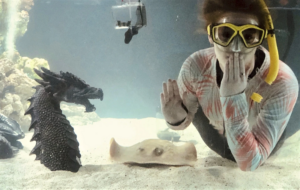Charlotte, a stingray with no male companion, is pregnant in her mountain aquarium

Charlotte, a rust-colored stingray the size of a serving platter, has spent much of her life gliding around the confines of a storefront aquarium in North Carolina’s Appalachian Mountains.
She’s 2,300 miles (3,700 kilometers) from her natural habitat under the waves off southern California. And she hasn’t shared a tank of water with a male of her species in at least eight years.
And yet nature has found a way, the aquarium’s owner said: The stingray is pregnant with as many as four pups and could give birth in the next two weeks.
Its biggest lesson now is on the process of parthenogenesis: a type of asexual reproduction in which offspring develop from unfertilized eggs, meaning there is no genetic contribution by a male.
The mostly rare phenomenon can occur in some insects, fish, amphibians, birds and reptiles, but not mammals. Documented examples have included California condors, Komodo dragons and yellow-bellied water snakes.
But Lyons isn’t at all shocked. Other kinds of sharks, skates and rays — a trio of animals often grouped together — have had these kinds of pregnancies in human care.
“I’m not surprised, because nature finds a way of having this happen,” she said.
To be clear, Lyons said, these animals are not cloning themselves. Instead, a female’s egg fuses with another cell, triggers cell division and leads to the creation of an embryo.
The cell that fuses with the egg is known as a polar body. They are produced when a female is creating an egg but usually aren’t used.
Ramer said she and others at the nonprofit at first thought that Charlotte had a tumor when they noticed a lump on her back that was “blowing up like a biscuit.” But an ultrasound revealed her pregnancy.
“We were all like, ’Shut the back door. There’s no way,” Ramer said. ”We thought we were overfeeding her. But we were overfeeding her because she has more mouths to feed.”
Charlotte currently lives in a tank that’s about 2,200 gallons (8,300 liters), or nearly the size of a construction dumpster. Ramer said they’re hoping to get a tank nearly twice that size to accommodate Charlotte’s offspring. They also want to put live cameras up for people to see them.
“It is very rare to happen,” Ramer said. “But it’s happening in the middle of the Blue Ridge Mountains in rural North Carolina, hundreds of miles from the ocean.”
“We should set the record straight that there aren’t some shark-ray shenanigans happening here,” said Lyons, whose graduate work focused on the species.
Round stingrays like Charlotte are abundant on the Pacific coasts of southern California and Mexico, often resting on the ocean’s sandy bottom near the shoreline.
In the wild they are typically the size of a small dinner plate, and their name comes from their circular shape. They come in all shades of brown. They eat small worms, crabs and mollusks, and they are preyed upon by certain types of sharks, seals and giant sea bass.
They’re well known to humans because of their painful sting, often resulting from a beachgoer’s foot stepping on them. Southern California lifeguards encourage people to do the so-called stingray shuffle as they wade through the water, in large part because of round stingrays.
Lyons finds the species fascinating. For example, embryos in the womb are bathed in uterine milk that provides nutrients to help them develop.
“I’m glad the round stingray is getting the media attention that it deserves,” Lyons said. “It’s not necessarily as sexy as a white shark, but they do a lot of really neat stuff.”



